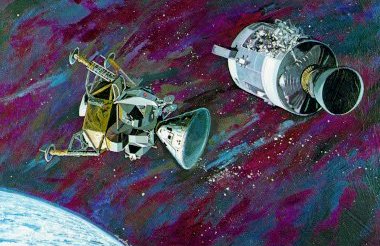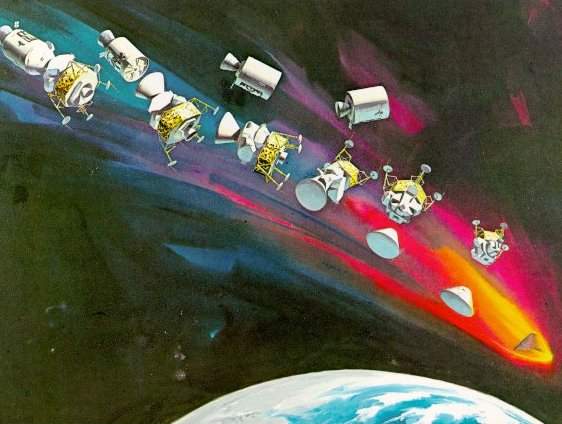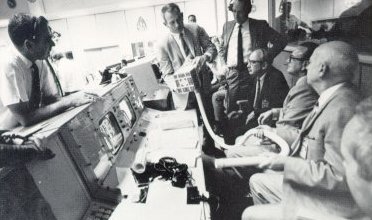Apollo Expeditions to the Moon
FIFTEEN MINUTES OF POWER LEFT
With only 15 minutes of power left in the CM, CapCom told us
to make our way into the LM. Fred and I quickly floated through
the tunnel, leaving Jack to perform the last chores in our
forlorn and pitiful CM that had seemed such a happy home less
than two hours earlier. Fred said something that strikes me as
funny as I read it now: "Didn't think I'd be back so soon." But
nothing seemed funny in real time on that 13th of April, 1970.
| | |
Blast-gutted service module was set adrift from
the combined command module and lunar module just four hours
before Earth reentry. Mission Control had insisted on
towing the wrecked service module for 300,000 miles
because its bulk protected the command module's heat
shield from the intense cold of space. The astronauts next
revived the long-dormant command module and prepared
to leave their lunar module lifeboat.
|
There were many, many things to do. In the first place, did
we have enough consumables to get home? Fred started calculating,
keeping in mind that the LM was built for only a 45-hour
lifetime, and we had to stretch that to 90. He had some data from
previous LMs in his book -- average rates of water usage related to
amperage level, rate of water needed for cooling. It turned out
that we had enough oxygen. The full LM descent tank alone would
suffice, and in addition, there were two ascent-engine oxygen
tanks, and two backpacks whose oxygen supply would never be used
on the lunar surface. Two emergency bottles on top of those packs
had six or seven pounds each in them. (At LM jettison, just
before reentry, 28.5 pounds of oxygen remained, more than half of
what we started with.)
We had 2181 ampere hours in the LM batteries. We thought
that was enough if we turned off every electrical power device
not absolutely necessary. We could not count on the precious CM
batteries, because they would be needed for reentry after the LM
was cast off. In fact, the ground carefully worked out a
procedure where we charged the CM batteries with LM power. As it
turned out, we reduced our energy consumption to a fifth of
normal, which resulted in our having 20 percent of our LM
electrical power left when we jettisoned Aquarius. We did have
one electrical heart-stopper during the mission. One of the CM
batteries vented with such force that it momentarily dropped off
the line. We knew we were finished if we permanently lost that
battery.
| | |
The jettisoning of elements during the critical
last hours of the Apollo 13 mission is shown in this sequence
drawing. When the lifesaving LM was shoved off by
tunnel pressure about an hour before splashdown, everyone
felt a surge of sentiment as the magnificent craft
peeled away. Its maker, Grumman, later jokingly sent
a bill for more than $400,000 to North American Rockwell
for "towing" the CSM 300,000 miles.
|
Water was the real problem. Fred figured that we would run
out of water about five hours before we got back to Earth, which
was calculated at around 151 hours. But even there, Fred had an
ace in the hole. He knew we had a data point from Apollo 11,
which had not sent its LM ascent stage crashing into the Moon, as
subsequent missions did. An engineering test on the vehicle
showed that its mechanisms could survive seven or eight hours in
space without water cooling, until the guidance system rebelled
at this enforced toasting. But we did conserve water. We cut down
to six ounces each per day, a fifth of normal intake, and used
fruit juices; we ate hot dogs and other wet-pack foods when we
ate at all. (We lost hot water with the accident and dehydratable
food is not palatable with cold water.) Somehow, one doesn't get
very thirsty in space and we became quite dehydrated. I set one
record that stood up throughout Apollo: I lost fourteen pounds,
and our crew set another by losing a total of 31.5 pounds, nearly
50 percent more than any other crew. Those stringent measures
resulted in our finishing with 28.2 pounds of water, about 9
percent of the total.
| | |
Carbon dioxide would poison the astronauts unless
scrubbed from the lunar module atmosphere
by lithium hydride
canisters. But the lunar module had only enough
lithium hydride for 4 man-days - plenty for the lunar landing but not
the 12 man-day's worth needed now. Here Deke Slayton (center)
explains a possible fix to (left to right) Sjoberg,
Kraft, and Gilruth. At left is Flight Director Glynn Lunney.
|
Fred had figured that we had enough lithium hydroxide
canisters, which remove carbon dioxide from the spacecraft. There
were four cartridge from the LM, and four from the backpacks,
counting backups. But he forgot that there would be three of us
in the LM instead of the normal two. The LM was designed to
support two men for two days. Now it was being asked to care for
three men nearly four days.
|



